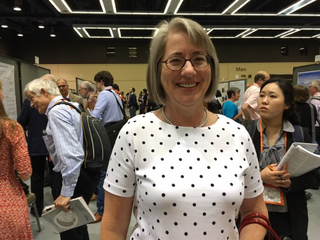ARVO 2016: ProgSTAR, FFB-CRI’s Stargardt Disease Patient Study, Highlighted
Eye On the Cure Research News
When the study and the reports are completed, the ProgSTAR database will be made available to researchers and companies developing therapies.

Janet Cheetham, Pharm.D., ProgSTAR’s liaison to FFB, attending ARVO 2016.
One of the hot topics at ARVO 2016 is ProgSTAR, the natural history study for people with Stargardt disease funded by the Foundation Fighting Blindness Clinical Research Institute (FFB-CRI). I caught up with Janet Cheetham, Pharm.D., the project's liaison to FFB, to explain why the effort is important to therapy development. Having spent more than three decades in the development of retinal and ophthalmological treatments at Allergan, she brings a wealth of insight and knowledge to her role.
What is ProgSTAR, and why is the study so important to therapy development?
We have 12 clinical sites around the world assessing the progression, over time, of Stargardt disease in more than 250 children and adult patients. By gaining an understanding of disease progression, we'll be able to recommend the efficacy measures—for example, changes in vision and/or retinal structure—that will be most efficient and reliable for evaluating potential therapies in clinical trials.
The information is being shared publicly through papers in peer-reviewed scientific journals. In addition, when the study and the reports are completed, the ProgSTAR database (without patients' private information) will be made available to researchers and companies developing therapies. We're confident the information will help tremendously in designing and launching clinical trials.
Why did FFB-CRI take the initiative to launch ProgSTAR?
The Foundation took the lead to launch this study because of the gap in understanding of Stargardt disease, which is the leading cause of inherited macular degeneration. It's imperative that we improve our understanding of the disease to select reliable efficacy measures in clinical trials of one or two years' duration. It's very difficult to attract investors to fund development of a therapy if a single clinical trial must be conducted for five years to determine if a therapy is saving vision. It's just too expensive.
How many presentations on ProgSTAR are being made at ARVO this year? Can you tell us about one?
I am delighted to report there are nine ARVO presentations of interim results from ProgSTAR. The one that I'm most interested in will discuss the changes in the size of lesions—i.e., the area of degeneration—and how that correlates with the rate of change in visual acuity. The reason this is important is that measuring visual acuity—that is, having the patient read an eye chart—is often not reliable. Results from acuity tests can vary significantly. However, even subtle changes in retinal structure are likely to be captured more quickly and accurately. That's our hope, and we launched ProgSTAR to see if we could scientifically prove this to be true.
How much has FFB-CRI invested in ProgSTAR?
We'll have spent about $6 million for the study, when it is completed. While this is a significant amount of money, it is well worth it because we have the opportunity to not only accelerate development of Stargardt disease therapies, but attract more companies and researchers to the space. With better clinical-trial endpoints, companies are more likely to invest in therapy development.




